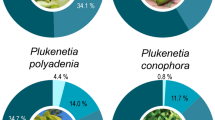Abstract
The fatty acid distribution in the seed flour from 31 Vicia taxa distributed throughout southern Spain was analyzed by gas chromatography. Fatty acids ranged from myristic acid to araquidic acid. Linoleic acid (from 28.7 to 66.3% of the fatty acids), oleic acid (from 7.2 to 32.5% of the fatty acids) and linolenic acid (from 2.7 to 16.6% of the fatty acids) were the most abundant among unsaturated ones and palmitic acid among saturated ones. The total unsaturated to saturated fatty acids ratio ranged between 2.6 in V. hirsuta and 4.2 in V. hybrida. Polyunsaturated to monounsaturated fatty acids ratio ranged between 1.3 in V. ervilia and 9.0 in V. pyrenaica. The ω-6 to ω-3 ratio ranged between 1.7 in V. articulata and 17.3 in V. faba. The fatty acids distribution observed in the Vicia species studied supports the use of these plants as a source of important dietary lipids.

Similar content being viewed by others
References
Hellendoorn EW (1976) Beneficial physiologic action of beans. J Am Diet Assoc 69:248–253
Morrow B (1991) The rebirth of legumes: legume production, consumption, and export are increasing as more people become aware of legumes nutritional benefits. Food Technol 45:96–121
Rochfort S, Panozzo J (2007) Phytochemicals for health, the role of pulses. J Agric Food Chem 55:7981–7994
Duranti M (2006) Grain legume proteins and nutraceutical properties. Fitoterapia 77:67–82
Akpinar N, Akpinar MA, Türkoglu S (2001) Total lipid content and fatty acid composition of the seeds of some Vicia L species. Food Chem 74:449–453
Salunkhe DK, Sathe SK, Reddy NR (1983) Legume lipids. In: Arora SK (ed) Chemistry and biochemistry of legumes. Edward Arnold, London
Zanarini MC, Frankenburg FR (2003) Omega-3 fatty acid treatment of women with borderline personality disorder: a double-blind, placebo-controlled pilot study. Am J Psychiat 160:167–169
Talavera S, Aedo C, Castroviejo S, Romero-Zarco C, Sáez L, Salgueiro FJ, Velayo M (eds) (1999) Flora Iberica, vol 7(1). CSIC, Madrid
Madar Z, Stark AH (2002) New legume sources as therapeutic agents. Brit J Nutr 88(S3):S287–S292
Yoshida H, Tomiyama Y, Yoshida N, Saiki M, Mizushina Y (2008) Lipid classes, fatty acid distributions and triacylglycerol molecular species of broad beans (Vicia faba). J Am Oil Chem Soc 85:535–541
Garcés R, Mancha M (1993) One-step lipid extraction and fatty acid methyl esters preparation from fresh plant tissues. Anal Biochem 211:139–143
Bray RJ, Curtis JI (1957) An ordination of the upland forest communities of southern Wisconsin. Ecol Monogr 27:325–349
Clevidence BA, Judd JT, Schaefer EJ, Jenner JL, Lichtenstein AH, Muesing RA, Wittes J, Sunkin ME (1997) Plasma lipoprotein (a) levels in men and women consuming diets enriched in saturated, cis-, or trans-monounsaturated fatty acids. Arterioscler Thromb Vasc Biol 17:1657–1661
Baer DJ, Judd JT, Kris-Etherton PM, Zhao G, Emken EA (2003) Stearic acid absorption and its metabolizable energy value are minimally lower than other fatty acids in healthy men fed mixed diets. J Nutr 133:4129–4134
Pastor-Cavada E, Juan R, Pastor JE, Alaiz M, Vioque E (2009) Chemical composition and nutritional characteristics of the seed oil of wild Lathyrus, Lens and Pisum species from southern Spain. J Am Oil Chem Soc 86:329–335
Maestri DM, Fortunato RH, Guzmán CA, Torres MM, Lamarque AL (2002) Seed compositional studies of some species of Papilionoideae (Leguminosae) native to Argentina. J Sci Food Agric 82:248–251
Bagci E, Bruehl L, Özçelik H, Aitzetmuller K, Vural M, Sahim A (2004) A study of the fatty acid and tocochromanol patterns of some Fabaceae (Leguminosae) plants from Turkey I. Grasas Aceites 55:378–384
Yoshida H, Tomiyama Y, Tanaka M, Mizushina Y (2007) Distribution of fatty acids in triacylglycerols and phospholipids from peas (Pisum sativum L.). J Sci Food Agric 87:2709–2714
Ajayi A, Oderinde RA, Kajogbola DO, Uponi JI (2006) Oil content and fatty acid composition of some underutilized legumes from Nigeria. Food Chem 99:115–120
Simopoulos AP (1991) Omega-3 fatty acids in health and disease and in growth and development. Am J Clin Nutr 54:438–463
Simopoulos AP (2002) Omega-3 fatty acids in inflammation and autoimmune diseases. J Am Coll Nutr 21:495–505
Simopoulos AP (2006) Evolutionary aspects of diets, the omega-6/omega-3 ratio and genetic variation: nutritional implications for chronic diseases. Biomed Pharmacother 60:502–507
Simopoulos AP (1999) Essential fatty acids in health and chronic disease. Am J Clin Nutr 70((Suppl)):560S–569S
Weber PC, Leaf A (1991) Cardiovascular effects of omega-3 fatty acids. Atherosclerosis risk factor modification by omega-3 fatty acids. World Rev Nutr Diet 66:218–232
Weber PC (1989) Are we what we eat? Fatty acids in nutrition and in cell membranes: cell functions and disorders induced by dietary conditions. In: Fish fats and your health. Svanoy Foundation, Norway, pp 9–18 (report no. 4)
FAO/WHO (1998) Preparation and use of food-based dietary guidelines. Report of joint FAO/WHO consultation. Technical report series no. 880, Geneva
Trozynska A, Honke J, Milczak M, Kozlowska H (1993) Antinutritional substances in lentil (Lens culinaris) and everlasting pea (Lathyrus sativus) seeds. Polish J Food Nutr Sci 2:49–54
Rotter RG, Marquardt RR, Campbell CG (1991) The nutritional value of low lathyrogenic lathyrus (Lathyrus sativus) for growing chicks. Brit Poultry Sci 32:1055–1067
Pirman T, Stibilj V (2003) An influence of cooking on fatty acid composition in three varieties of common beans and in lentil. Eur Food Res Technol 217:498–503
Acknowledgments
This work was supported by grant AGR-711 from the Junta de Andalucía (Spain). Thanks are due to Alvaro Villanueva and Carlos de la Osa for technical assistance.
Author information
Authors and Affiliations
Corresponding author
About this article
Cite this article
Pastor-Cavada, E., Juan, R., Pastor, J.E. et al. Fatty Acid Distribution in the Seed Flour of Wild Vicia Species from Southern Spain. J Am Oil Chem Soc 86, 977–983 (2009). https://doi.org/10.1007/s11746-009-1426-z
Received:
Revised:
Accepted:
Published:
Issue Date:
DOI: https://doi.org/10.1007/s11746-009-1426-z



